For those of you who requested more travel stories, well, it's not always about the pretty pictures. Oh, don't worry, you'll eventually get the pretty pictures but later. Later. Perhaps this post will signal the beginning of more random musings. Perhaps not.
I had intended to post more travel stories, but wasn't quite sure where to begin. And then last week, three things converged. It began with a discussion with Oanh of Halfway Between Ca Mau and Saigon about Cambodian influences on Vietnamese cuisine, and vice versa. My cousin's Cambodian friend, whom we consider an honorary family member, came into town. And Dith Pran, New York Times photographer and Killing Fields survivor, died on March 30 from pancreatic cancer.
But this story, for me anyway, really began almost 30 years ago. In first grade, the only thing I knew about Cambodia was what my friend told me. It was a poor country. Pol Pot and the Khmer Rouge killed many of her family members. And when the milk went sour, she still drank it because food was never wasted. I never really questioned these things. Afterall, Vietnam was also a poor country, my family had also survived a war, and food was a luxury for us too. We probably gravitated toward each other because we were the only Asian refugee kids in the class. (At the time, I was the only one of my cousins in school, and their cousins were in different grades.) She moved away after that year.
In 1984, when the film "The Killing Fields" aired on television, Cambodia meant countless atrocities and sadness. The Khmer Rouge killed 25% of Cambodia's population, an estimated 1.5 to 2 million people died from starvation, forced labor, or were massacred. Cambodia's population in 1975 was about 7.5 million. The movie is the reenactment of Dith's story, of his escape from Cambodia, and the horrors he witnessed. He coined the term "The Killing Fields." I was honored to meet him in 1997. I'd encourage you to read the New York Times' obituary and special section on Dith to gain more insight into this remarkable man.
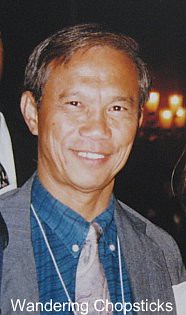
In college, I volunteered to tutor Southeast Asian (mainly Cambodian) kids at a drop-in center in Chicago's Uptown neighborhood. Many of the kids came from dysfunctional families. Their parents had gambling and alcohol addictions, and untreated psychological trauma from enduring the Killing Fields firsthand.
Years and years later, during the summer of 2005 when I was in Vietnam, I and two friends went to Siem Reap, Cambodia for the weekend to explore the Angkor archaeological ruins. (Don't worry, I'll show you see the pretty pictures of Angkor Wat and other temples in later posts.)
I knew about the Tuol Sleng Genocide Museum in Phnom Penh and asked if there was something in Siem Reap as well. On the last day of our trip, our tour guide took us to a Buddhist monastery where skulls and bones of victims of the Killing Fields were laid to rest.
What absolutely floored me though was that one of my friends, who was 21 years old at the time, had never heard of the Killing Fields at all. I tried to remember if I was ever taught about this in school and honestly couldn't remember. I know in 8th grade US history, we touched upon the Vietnam War, so there might have been a few paragraphs devoted to Cambodia. And in 11th grade US history, we never got to the Vietnam War at all. I just knew. Because I interacted with people who knew. And I asked to see the Killing Fields memorial in Siem Reap because it didn't seem right to play tourist in nearby Angkor and not acknowledge Cambodia's tragic past.
Of course, not everyone chooses to do so. We didn't encounter any other tourists while we were there. So although this technically happened at the end of my trip, I'll begin my story here. Our tour guide said these bones were found in the fields. They gathered whatever they found, including clothing, and placed them in this stupa near a Buddhist monastery. I'll let the pictures speak for themselves.
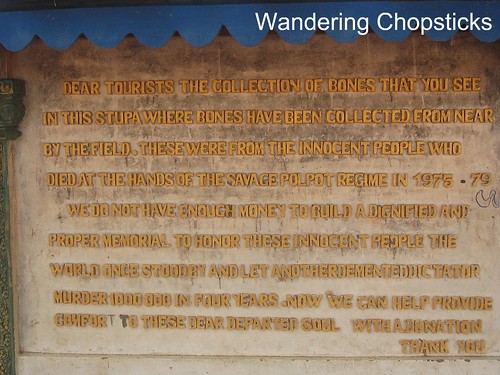
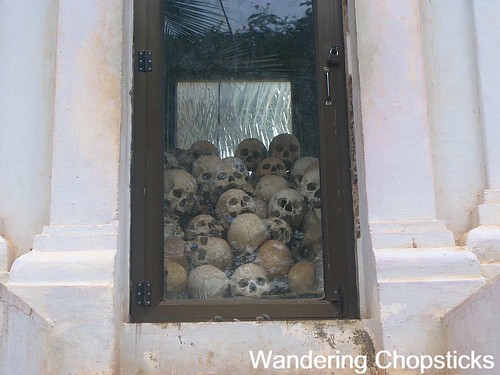

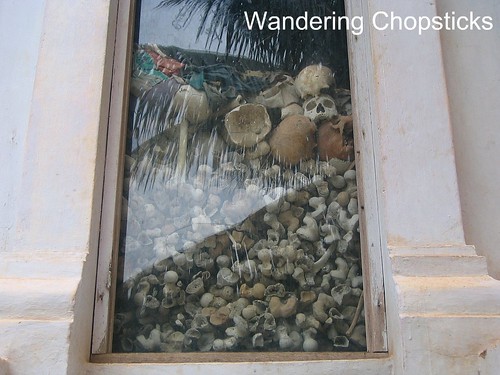
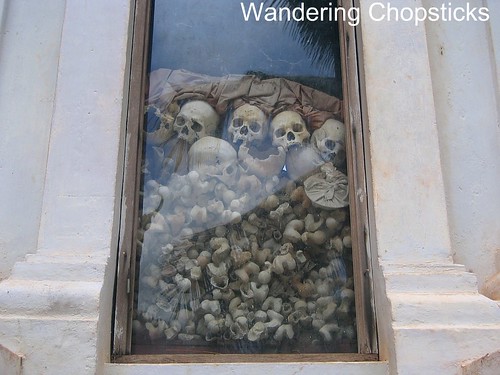
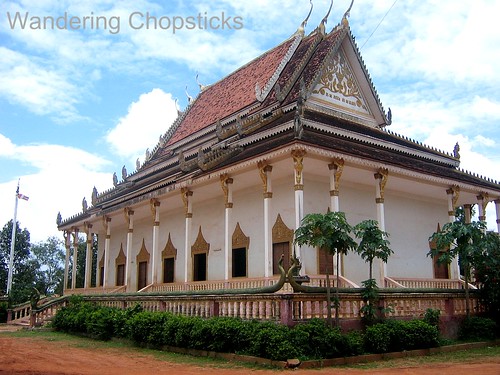
I suggest reading my Cambodia series in this order:
Dith Pran and the Killing Fields Memorial in Siem Reap - Cambodia
Khmer Classical Dance at Koulen Restaurant - Siem Reap - Cambodia
Angkor Wat
Angkor Thom: Victory Gate, Bayon Temple, Terrace of the Leper King, Terrace of the Elephants, Prasats Suor Prat, and Phimeanakas
Ta Prohm
Chong Kneas Floating Village - Tonle Sap (Great Lake) - Cambodia
For a related post on Cambodian food:
Battambang Seafood Restaurant - San Gabriel
*****
1 year ago today, popcorn chicken, butter toast, tea-flavored egg rolls, and freshly brewed tea at Tea Station - Alhambra.

This was a very emotional piece for me to read.
ReplyDeleteYou're right, most American kids learn about the Vietnam war, but they know little of the stories about Cambodia, Burma (now Myanmar), Laos. It's like history forgot about them. Thank you for reminding us.
I am Cambodian, and appreciate your comment! Hope more Americans know about this history.
DeleteI guess the reason why the Killing Field is not a popular tourist destination is: a/ People are not interested in history, or b/ they don't want to go there.
ReplyDeleteI didn't go there on my Cambodian trip for the second reason. I have mixed feelings about visiting historical sites when I travel. Sure I'm very interested in history and such, but seeing evidences of human cruelty is sometimes too disturbing to me. I got really emotional when I visited a historical Jewish ghetto in Poland, so much that I decided not to go to Auschwitz. Reading is one thing, seeing the evidence is ten-fold the effect.
I guess you're tougher than me. Kudos to bravery :-)
My opinion about the Killing Field is not popular is not about people not interested in history, but the world and some countries try to forget their bad past! Even Cambodia's education itself, never mention about Pol Pot regime. I myself only knew from my parents who had gone through this worse war. They kept telling us how precious food was at that time.
DeleteBut i understand and agree with your second para, about not daring to see Toul Sleng.
Thanks for starting this story.
ReplyDeleteThe memorial is so much more poignant as it is. The simple words, and confronting the visitor with the sheer number of deaths.
N makes an interesting point about visiting historical sites and evidence of human cruelty. I'm going to think about that some more, especially in light of one of your points - made in your post and also intensified by the simple sign - that people just don't know about the Killing Fields, and the monks do not have enough money to commemorate their innocent lives, as they should.
I look forward to reading more. What is food, without the stories?
DP,
ReplyDeleteThe sad part is that there's always another war, more tragedy of other places we don't think about too.
N and Oanh,
Sometimes it's simpler than that. I think a lot of people just don't know. But also, I think there's a difference in paying respects to victims, like I'm doing here, and visiting scenes where cruelties were inflicted, like the concentration camps. I don't think I could bear to be where such horrors actually happened. Splitting hairs, I know, but somehow that makes visiting such memorials not nearly as disconcerting.
Also, after spending so much time with our tour guide and driver, I would feel as if I didn't acknowledge what happened to their families if I glossed over this. They wouldn't have mentioned the memorial if I hadn't asked.
Great post, WC. I'm fairly certain I didn't learn anything about Cambodia when I was in high school, and very little about Vietnam. The only thing I new about Cambodia was from the quick bits of Pol Pot that was shown on the news. It wasn't until I was in college, when information was more readily available (Asian studies classes) that I learned more.
ReplyDeleteThanks for sharing.
Hey WC - Long ago and far away; I once dated a Young Lady who, managed to escape Cambodia with her Mother....the stories She told me were tragic and disheartening, and yet she was one of the most warm and optimistic persons I had ever met, I had thought that this was her personality. But after visiting Cambodia, we were simply amazed at how kind, warm, and optimistic the people we met were......in spite of the terrible atrocities of recent time.
ReplyDeleteMarvin,
ReplyDeleteI think that's probably how it works for a lot of people. My friend was pre-med though so I don't think she took any Asian studies courses. Still, it boggles my mind that she didn't know anything at all.
Kirk,
I'm glad you had such a great experience there. I'm always amazed at how people manage to endure such things and still move forward with hope.
Thank you for this post. I really hope that I can visit Cambodia for my first SE Asia trip (next year, perhaps). Although my major in college was biology, it was through my anthropology minor classes that really opened my eyes to the world...especially my SE Asian studies class. Such a horrible thing to have happened, yet it continues around the world to this day.
ReplyDeleteThis literally brought tears to my eyes.. I have always enjoying reading your posts.. but this one.. oh my gosh... I am sad to say that I do not know about this and read the wiki article. But it must have been humbling to be there... But it was so stark to see the skulls.. that millions have died and for the bones to be displayed that way... It is so tragic..
ReplyDeleteYou know I love your food/recipe posts, but who can resist a photographic educational post (or five!). Looking forward to more of your commentary.
ReplyDeleteHis story along with the untold stories of others are just amazing.
ReplyDeleteThanks for writing about this! I want to watch the movie!
Christine D.,
ReplyDeleteI think that's what so sad. That even after the Killing Fields, we still see such atrocities happening around the world. :(
Sailor Pika Angel,
I'm so touched that this post affected you. I do try and it's always nice to hear if I educate someone new.
Nikki,
I hope you enjoy reading all of them.
Jeannie,
Please do! The movie is very hard to watch because it is so stark, but very true to the experience and to his story.
Thank you for the amazing and emotion post! There are not many Asian kids in western do care about the history which only just happened 30 years ago!
ReplyDeleteRath,
ReplyDeleteI just couldn't believe my friend knew nothing about it. This should be part of every history class!